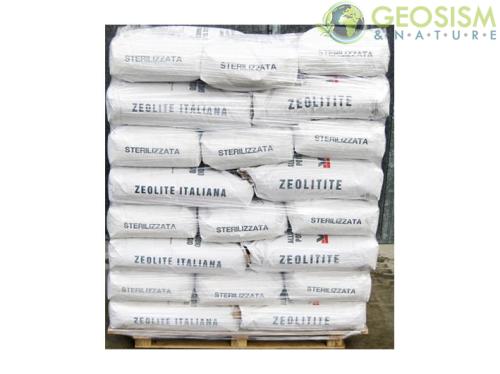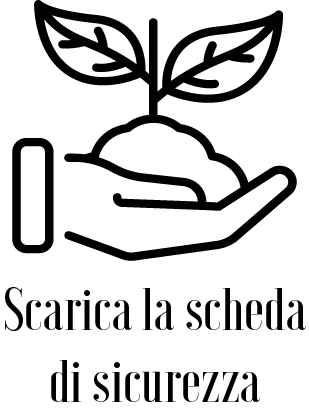Zeolite based on Chabasite and Phillipsite 2/5 mm (pallet of 62 20 kg bags), soil conditioner for plants
ZEOLITE BASED ON CHABASITE AND PHILLIPSITE 2/5 mm (pallet of 50 bags of 20 kg) , soil conditioner for plants.
Group of minerals made up of 52 mineralogical species chemically defined as "hydrated aluminosilicates of alkaline and/or alkaline earth elements" (essentially, Na, K and Ca) and structurally constituting the tectosilicate family with feldspars, feldspathoids and silica minerals. In this family of silicates, the primary structural units, tetrahedra [(Si,Al)O4], are connected to each other in the three directions of space to form three-dimensional scaffolds resulting in a ratio between tetrahedral cation (Si, Al) and oxygen of 1: 2.
Unlike what occurs in other families of silicates where the same structural units are isolated (nesosilicates, e.g. olivines), connected in a single direction (inosilicates, e.g. pyroxenes) or in two directions (phyllosilicates, e.g. clay minerals ), the three-dimensional tetrahedral framework of tectosilicates gives rise to "open" structures due to the presence of extratretrahedral cavities of increasing volume from feldspars and silica minerals to feldspathoids to zeolites.
The three-dimensional tetrahedral scaffold of zeolites is "very open" (low tetrahedral density) and, as such, has large internal cavities (from 20 to 50% of the volume of the crystal) communicating with each other and with the outside through molecular-sized channels (2.5 to about 7 Å; 1 Å = 10-8 cm).
In the natural state, cavities and channels are occupied by cations (Na, K, Ca) and water molecules. The cations, necessary to balance the negative electrical charges of the tetrahedral scaffold due to the partial replacement of Si4+ with Al3+, being weakly bound to the tetrahedral scaffold, enjoy a certain freedom of movement and can exit, through the channels, from the cavities and therefore from the crystal only if replaced by other cations carrying the same number of positive electric charges.
This property, known as "cation exchange capacity" (CSC), has an intensity (expressed in meq/g) increasing with increasing Al content in the tetrahedra and varies from around 2 meq/g in zeolites poor in Al (clinoptilolite , ferrierite tenerite) at 3-4 meq/g in Al-rich zeolites (chabasite, phillipsite).
The water, from 10 to 20% by weight depending on the zeolitic species, can be easily and more or less continuously removed by heating below 300-350° C with no or modest modifications of the tetrahedral framework.
The zeolites dehydrated in this way have a large internal surface (up to a few hundred m2 per gram of substance) available to host water molecules or other molecules with natural or induced polarity. The dehydration-rehydration process is almost infinitely reversible and the absorption of polar molecules occurs according to a rigid "selection" based "primarily" on the size of the molecules and, secondarily, on their degree of polarity.
The material is sterilized in the oven up to a temperature of 200°C for 20 minutes, the finest and dustiest part has a high sterilizing power against fungal pathologies (mold and fungi).
MEDIA CHEMICAL ANALYSIS
Determined by X-ray fluorescence and calcination loss
SiO2: 52.0%
Al2O3: 17.0%
K2O: 6.1%
Fe2O3: 3.6%
CaO: 5.7%
Na2O: 0.6%
TiO2: 0.5%
MgO: 2.3%
H2O (Structure lost above 120°C): 12.0%
MnO: 0.2%
P2O5: 0.3%
TECHNICAL FEATURES
DEFINITION: POTASSIUM, SODIUM AND CALCIUM SILICATE
Volcanic rock with a high capacity for cation exchange and water absorption due to the prevalent content of chabasite and phillipsite "tectosilicate" minerals and the lithological texture;
QUALI-QUANTITATIVE MINERALOGICAL COMPOSITION: (in % with standard deviations) determined by X-ray with the Rietveld-RIR method (Gualtieri, 2000): chabasite 60 ± 5; phillipsite 5 ± 3; k-feldspar 4 ± 2; biotite 2 ± 1; pyroxene 4 ± 1; volcanic glass 25 ± 5;
CABASITE CONTENT [(Na0.14 K1.03Ca1.00Mg0.17)[Al3.46 Si8.53O24] 9.7 H2O] AND PHILLIPSITE: 65 ± 5%;
HEAVY ELEMENTS: quantity (ppm) released by elution according to the IRSA-CNR procedure (1985): Pb 10; As 5; Cd 2; Zn 20; Cu tr;
pH: 6.9 ? 7.1
HIGH CATION EXCHANGE CAPACITY: 2.1 ± 0.1 meq/g with marked selectivity towards cations with low solvation energy (NH4, K, Pb, Ba)
HIGH STRUCTURAL CRYPTOPOROSITY: from 20 to 50% of the volume of the crystal;
REVERSIBLE DEHYDRATION: dehydration (endothermic process) - rehydration (exothermic process) infinitely reversible and therefore potential to attenuate the positive and negative peaks of the degree of humidity and environmental temperature;
MOLECULAR SIEVING ;
WATER RETENTION: 30-40% (w/w) depending on the grain size;
MECHANICAL RESISTANCE ;
PERMEABILITY ;
APPARENT DENSITY: 0.70 g/cm3 ? 0.90 g/cm3 depending on the grain size.
FUNCTIONAL CHARACTERISTICS AND FIELDS OF USE
Lightweight natural aggregate, ideal for:
? allows you to reduce watering by 30-40% thanks to the characteristics described above;
? neutralizes harmful elements, ammonium, heavy metals, organic molecules;
? absorbs odorous gases, ammonia, hydrogen sulphide, mercaptans;
? improves the exploitation of fertilizers by consequently reducing the quantities to be used;
? waste water purification;
? rooting substrate (sowings, cuttings, transplants, soilless cultivation and hydroculture);
? preparation of universal soils;
? preparation of specific soils (annual plants, acidophilic plants, succulents, houseplants, lawns...);
? preparation of professional soils for outdoor vegetable and flower nurseries and for protected crops;
? soil amendment;
? hydroculture;
? drainage;
? animal feeding, in quantities varying between 2 and 3% (reduction in the N-ammonia content of sewage, reduction of intestinal and respiratory diseases, inhibition of the absorption of afla- and mycotoxins by animals, slight improvement of feed conversion index, reduction of NH3 content and bad odors in farms and surrounding areas).
NB: SHIPPING INFORMATION
THE PALLET FOR SALE WEIGHS 1,300 KG, THEREFORE IT CANNOT BE UNLOADED BY THE COURIER IN CHARGE OF DELIVERY WITH THE HYDRAULIC TAIL TAIL OF THE TRUCK (THE HYDRAULIC TAIL TAILS OF TRUCKS CAN UNLOAD UP TO A MAXIMUM OF 1,200 KG) SO IT WILL BE THE BUYER'S RESPONSIBILITY TO PROVIDE THIS UNLOADING THE BIG BAG USING YOUR OWN VEHICLES (FREE FORKLIFTS, MECHANICAL LOADERS EQUIPPED WITH FORKS OR TRACTORS EQUIPPED WITH FORKS ABLE TO LIFT THE WEIGHT IN QUESTION).
NB: AVAILABILITY OF THE MATERIAL
The material is subject to availability, it is usually taken directly from the manufacturer in the quarry and shipped to the customer in order to always have a clean product in excellent condition. We therefore ask our kind customers to check availability and delivery times by contacting Geosism & Nature sas














